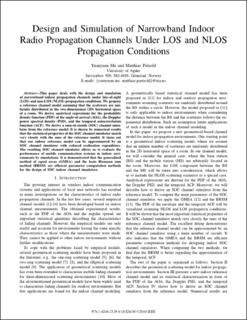| dc.contributor.author | Ma, Yuanyuan | |
| dc.contributor.author | Pätzold, Matthias | |
| dc.date.accessioned | 2010-11-22T16:17:20Z | |
| dc.date.available | 2010-11-22T16:17:20Z | |
| dc.date.issued | 2010 | |
| dc.identifier.citation | Ma, Y., & Pätzold, M. (2010). Design and Simulation of Narrowband Indoor Radio Propagation Channels under LOS and NLOS Propagation Conditions. Paper presented at the 2010 IEEE 71st Vehicular Technology Conference (VTC 2010-Spring) Taipei. | en_US |
| dc.identifier.isbn | 978-1-4244-2518-1 | |
| dc.identifier.uri | http://hdl.handle.net/11250/137821 | |
| dc.description | Paper presented at the 2010 IEEE 71st Vehicular Technology Conference. (c) 2010 IEEE. Personal use of this material is permitted. Permission from IEEE must be obtained for all other users, including reprinting/ republishing this material for advertising or promotional purposes, creating new collective works for resale or redistribution to servers or lists, or reuse of any copyrighted components of this work in other works. Paper also available from the publisher: http://dx.doi.org/10.1109/VETECS.2010.5494116 | en_US |
| dc.description.abstract | This paper deals with the design and simulation of narrowband indoor propagation channels under line-of-sight (LOS) and non-LOS (NLOS) propagation conditions. We propose a reference channel model assuming that the scatterers are uniformly distributed in the two-dimensional (2D) horizontal space of a room. We derive analytical expressions for the probability density function (PDF) of the angle-of-arrival (AOA), the Doppler power spectral density (PSD), and the temporal autocorrelation function (ACF). We derive a sum-of-cisoids (SOC) channel simulator from the reference model. It is shown by numerical results that the statistical properties of the SOC channel simulator match very closely with the ones of the reference model. It turns out that our indoor reference model can be approximated by an SOC channel simulator with reduced realization expenditure. The resulting SOC channel simulator allows us to evaluate the performance of mobile communication systems in indoor environments by simulations. It is demonstrated that the generalized method of equal areas (GMEA) and the basic Riemann sum method (BRSM) are efficient parameter computation methods for the design of SOC indoor channel simulators. | en_US |
| dc.language.iso | eng | en_US |
| dc.publisher | IEEE | en_US |
| dc.title | Design and Simulation of Narrowband Indoor Radio Propagation Channels under LOS and NLOS Propagation Conditions | en_US |
| dc.type | Chapter | |
| dc.type | Peer reviewed | |
| dc.subject.nsi | VDP::Mathematics and natural science: 400::Information and communication science: 420::Communication and distributed systems: 423 | en_US |
| dc.subject.nsi | VDP::Technology: 500::Information and communication technology: 550::Telecommunication: 552 | en_US |
